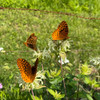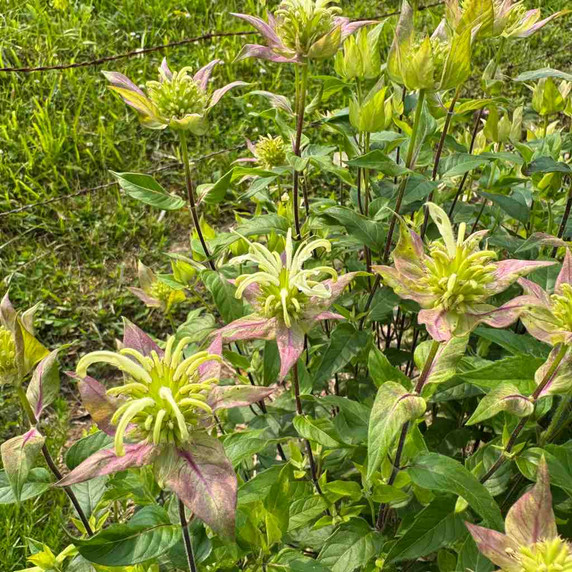Monarda luteola 'Coconut Lime' - YELLOW BEEBALM 'COCONUT LIME'
Plant Delights Nursery superior selection of native perennial from Arkansas!
Expands wide assortment of beebalms and deer resistant plants.
The species is early extinct in nature, so by planting this gem, you help to preserve it ex site (out of it's natural area).
Very unusual greenish-pink bracts, chartreuse-cream buds that open into coconut cream flowers.
Very ornamental before the flowers open. Lemon-y aroma. Blooms slightly before other Monarda cultivars.
It doesn’t suffer with powdery mildew even in hot and humid climates.
Magnet for bumblebees and butterflies, and some native bees (depending on your area).
Vigorous plant that will form several ft wide clump in years.
Blooming Time: June
Size: 30" tall and 24" wide, but in time will spread into very clumps of several feet wide
USDA Zones: 4a to 8
Culture: full sun, grows well in average soil with some organic matter, loam. Drought tolerant.
Moisture Needs: medium-dry, medium
Origin: Introduced by Plant Delights Nursery, from the Arkansas genotype plants. The species grows naturally in a small area on the border of Texas and Arkansas (Weches Geologic Formation). Was recognized as a species in 2011 and is ranked as G2 plant (= in the high risk of extinction due to factors like a very restricted range, a small number of populations or significant population declines).
Deer/Rabbit Resistant: yes / yes
Attracts Butterflies or Pollinators: offers nectar to long-tongued bees, bumblebees, butterflies, skippers, hummingbird moths, and bee flies. Caterpillars of several moths feed on the foliage (also on other species of Monarda), as well as beetles.
Attracts Hummingbirds: yes
Pot Size: 3.5" x 4" perennial pot (1.22 pt/580 ml)
Pictures copyright: US Perennials
Plant combinations: A great choice for a sunny flower border, butterfly garden, bumblebee garden, hummingbird garden, low maintenance garden, deer resistant landscaping, for naturalizing in sunny woodland edges. Goes well with many perennials (native and not native). Amorpha canescens, Asclepias tuberosa, Asclepias verticillata, Aster oblongifolius, Aster laevis, Aster ericoides, Coreopsis, Cunila origanoides, Echinacea purpurea hybrids, Echinacea tennesseensis, Echinacea pallida or angustifolia, Echinacea paradoxa, Euphorbia corollata, Penstemon, Pycnanthemum, Rudbeckia, Salvia, Solidago, and grasses like Boutelloua gracilis, Eragrostis elliotii, Koeleria macrantha or cristata, Muhlenbergia capillaris, Sporobolus heterolepis, and Schizachyrium scoparium.
From non-native perennials, choose Allium 'Millenium', Nepeta, Calamintha nepeta, Iris x germanica, Iris tectorum, Hemerocallis, Lavandula officinalis, Lavandula x intermedia, Perovskia, Stachys byzantina, Stachys macrantha and and other drought tolerant perennials.

Monarda luteola 'Coconut Lime' - YELLOW BEEBALM 'COCONUT LIME'
Plant Delights Nursery superior selection of native perennial from Arkansas!
Expands wide assortment of beebalms and deer resistant plants.
The species is early extinct in nature, so by planting this gem, you help to preserve it ex site (out of it's natural area).
Very unusual greenish-pink bracts, chartreuse-cream buds that open into coconut cream flowers.
Very ornamental before the flowers open. Lemon-y aroma. Blooms slightly before other Monarda cultivars.
It doesn’t suffer with powdery mildew even in hot and humid climates.
Magnet for bumblebees and butterflies, and some native bees (depending on your area).
Vigorous plant that will form several ft wide clump in years.
Blooming Time: June
Size: 30" tall and 24" wide, but in time will spread into very clumps of several feet wide
USDA Zones: 4a to 8
Culture: full sun, grows well in average soil with some organic matter, loam. Drought tolerant.
Moisture Needs: medium-dry, medium
Origin: Introduced by Plant Delights Nursery, from the Arkansas genotype plants. The species grows naturally in a small area on the border of Texas and Arkansas (Weches Geologic Formation). Was recognized as a species in 2011 and is ranked as G2 plant (= in the high risk of extinction due to factors like a very restricted range, a small number of populations or significant population declines).
Deer/Rabbit Resistant: yes / yes
Attracts Butterflies or Pollinators: offers nectar to long-tongued bees, bumblebees, butterflies, skippers, hummingbird moths, and bee flies. Caterpillars of several moths feed on the foliage (also on other species of Monarda), as well as beetles.
Attracts Hummingbirds: yes
Pot Size: 3.5" x 4" perennial pot (1.22 pt/580 ml)
Pictures copyright: US Perennials
Plant combinations: A great choice for a sunny flower border, butterfly garden, bumblebee garden, hummingbird garden, low maintenance garden, deer resistant landscaping, for naturalizing in sunny woodland edges. Goes well with many perennials (native and not native). Amorpha canescens, Asclepias tuberosa, Asclepias verticillata, Aster oblongifolius, Aster laevis, Aster ericoides, Coreopsis, Cunila origanoides, Echinacea purpurea hybrids, Echinacea tennesseensis, Echinacea pallida or angustifolia, Echinacea paradoxa, Euphorbia corollata, Penstemon, Pycnanthemum, Rudbeckia, Salvia, Solidago, and grasses like Boutelloua gracilis, Eragrostis elliotii, Koeleria macrantha or cristata, Muhlenbergia capillaris, Sporobolus heterolepis, and Schizachyrium scoparium.
From non-native perennials, choose Allium 'Millenium', Nepeta, Calamintha nepeta, Iris x germanica, Iris tectorum, Hemerocallis, Lavandula officinalis, Lavandula x intermedia, Perovskia, Stachys byzantina, Stachys macrantha and and other drought tolerant perennials.








